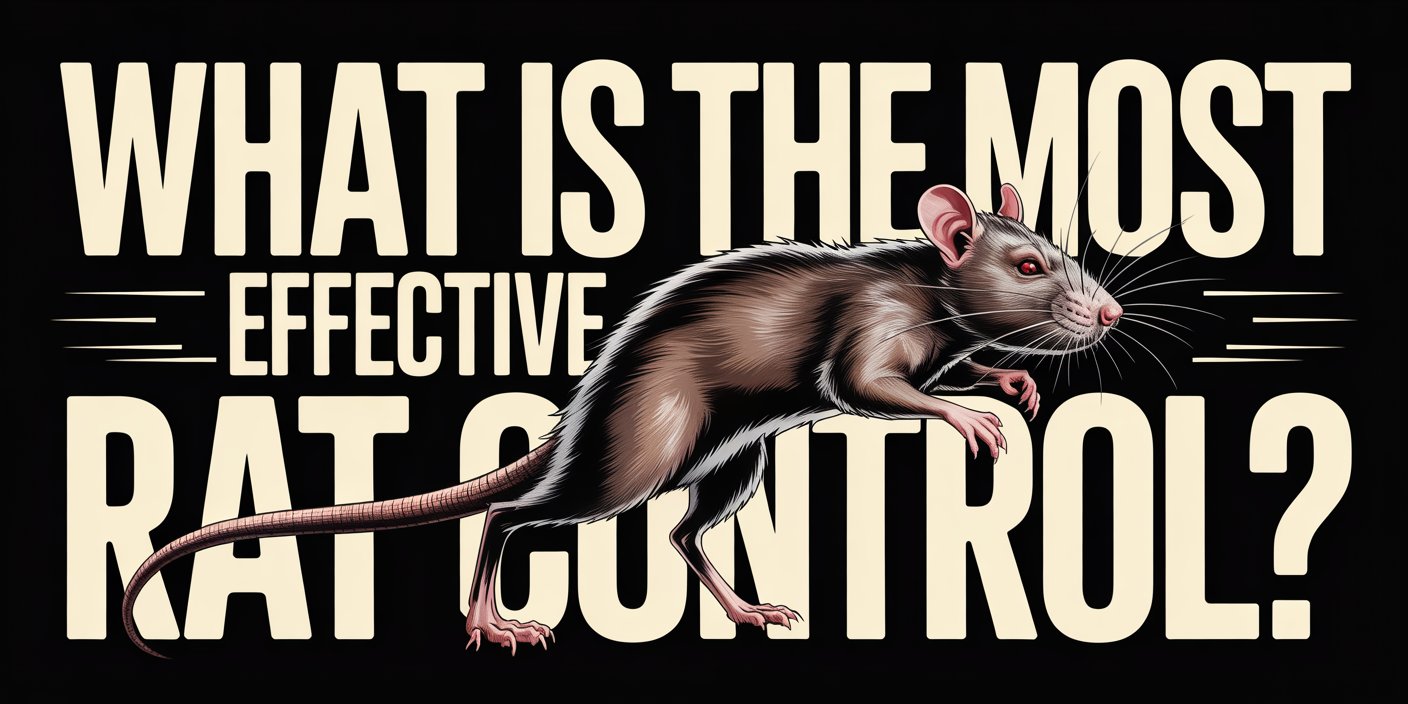“The most effective rat control combines sealing every entry point, eliminating food sources, and using snap traps strategically. It’s not just about killing rats—it’s about making your space unlivable for them. Long-term success comes from consistency, cleanliness, and knowing when to call in professional help.”
Rats never just “visit.” Once they find shelter, food, and water on your property, they settle in fast and start multiplying even faster. A single pair of rats can produce up to 2,000 descendants in one year if left unchecked, which means even a small sighting can signal a much larger problem brewing behind the walls. Beyond the mess they leave behind, rats can trigger allergies, contaminate food, and chew through insulation, electrical wiring, and even plastic pipes—creating serious fire and plumbing hazards. If you’re seeing droppings, hearing scratching at night, or noticing a musky odor, it’s time to act fast. That’s where AAAC Wildlife Removal comes in for expert rat removal.
This guide cuts through the noise and gives you a clear, field-tested game plan to get rid of rats and keep them out. You’ll learn how to identify entry points that rats use to sneak in, set traps effectively (without wasting time or bait), and remove the food and shelter sources that make your home so appealing. We’ll also cover when and how to use bait stations responsibly, and when to call in a pest control pro for backup. Rat control works best when it’s proactive, layered, and consistent—and this guide lays out each step so you’re not left guessing. With the right approach, you can protect your space, your health, and your sanity from a full-blown rat invasion.
Learn more: What’s the fastest way to get rid of rats?
1. Seal Every Entry Point
Rats are masters of sneaking in through the smallest cracks, often slipping through holes no bigger than a quarter. The first and most critical step in effective rat control is sealing up every possible access point around your home or building. Start with a full inspection—look around the foundation, roofline, vents, attic, crawl spaces, and where pipes or cables enter the walls. Don’t forget garage doors, under sinks, and basement windows. These rodents are agile climbers and can even scale rough walls or wires to reach the roof, so check high and low.
Once you’ve identified the weak spots, use durable, rat-proof materials to block them off. Steel wool combined with caulk is great for smaller holes, while hardware cloth or sheet metal works best for larger gaps. Avoid spray foam by itself—it may look sealed, but rats can chew right through it. Weather stripping, door sweeps, and chimney caps can also make a big difference. By sealing entry points before setting traps or bait, you’re cutting off the rats’ reinforcements and stopping the infestation at its source.
2. Set Snap Traps (Correctly!)
Snap traps are still one of the most effective ways to kill rats quickly and cleanly—if you know how to use them right. Many people make the mistake of placing just one or two traps and hoping for the best, but that won’t cut it for a serious infestation. Rats are cautious by nature, especially around new objects, so you need to be strategic. Place traps along baseboards, behind appliances, and near known rat pathways or droppings. Rats tend to run alongside walls rather than out in the open, so always set the trap with the bait side facing the wall.
When it comes to bait, skip the cheese cliché. Rats love high-protein foods like peanut butter, bacon bits, nuts, or even dried fruit. A small amount is enough—they’re drawn by scent, not quantity. Wear gloves to avoid leaving your scent on the trap, and check them daily so you can remove and reset as needed. Using multiple traps in active zones gives you better coverage and faster results. If done properly, you can significantly reduce the rat population within a few days.
3. Keep It Clean & Unappetizing
Rats are opportunistic scavengers, and a messy space is basically an open invitation. Crumbs on the floor, overflowing trash, and pet food left out overnight are all prime attractions for rodents. To truly get rid of rats, you need to make your home—or business—less welcoming. That means cleaning up food spills immediately, sweeping and vacuuming regularly, and wiping down counters and surfaces daily. If you have outdoor trash bins, make sure they’re sealed tight and stored away from the building.
Inside, store dry goods like cereal, rice, and flour in airtight containers, not flimsy packaging. Don’t forget about garages and pantries where bird seed, dog food, or snacks may be stored in bulk—those are rat magnets. Limit clutter wherever possible, especially piles of cardboard, clothing, or old furniture that rats can use for nesting. Outdoors, trim overgrown bushes, clean up fallen fruit, and move compost bins away from the house. The less access rats have to food and shelter, the harder it’ll be for them to stick around. Cleanliness doesn’t just support prevention—it reinforces every other control method you’re using.
4. Use Rodent Bait Stations (with Caution)
When traps alone can’t keep up—especially if you’re battling a Norway rat in the basement or a nimble roof rat in the attic—tamper-resistant bait stations add serious muscle to your overall rodent control plan. Each station houses poison bait that looks and smells like a tasty food source, luring rats to nibble and then carry the toxin back to their nest. Over time, this chain reaction helps get rid of rodents hiding in wall voids, crawl spaces, and other hard-to-reach areas. Because the bait is sealed inside a locked box, kids, pets, and non-target wildlife stay safe—just be sure never to scatter loose bait where curious paws can find it.
Use stations as part of an integrated strategy, not a stand-alone fix. Unless you’re experienced, bring in a licensed pro who knows where to place units for maximum punch, how to rotate baits so rats don’t wise up, and how to deal with the occasional dead rat that might end up behind drywall. Professional help ensures you truly get rid of rodents instead of chasing them in circles and keeps your home smelling fresh. Done correctly, bait stations can shrink even heavy infestations and keep them from rebounding.
5. Call a Professional
If you’ve sealed up entry points, cleaned meticulously, and set plenty of traps—and you’re still seeing signs of rats—it’s time to bring in the pros. Pest control professionals are trained to assess the full scope of an infestation and can spot things the average homeowner might miss. They have access to commercial-grade tools and treatments that aren’t available to the public, including tracking powders, high-strength bait formulations, and advanced exclusion materials. More importantly, they know how to use them safely and effectively.
A professional will also offer long-term solutions, like ongoing monitoring and prevention plans that keep rats from coming back. They’ll inspect the structure inside and out, identify nesting areas, and customize a strategy based on your property and environment. While it might cost more upfront, professional help often ends up saving time, money, and frustration in the long run. If you’re hearing noises in the walls or spotting rats during the day, don’t wait—those are signs of a serious infestation that needs expert intervention.
Conclusion- Final Thoughts Of The Most Effective Rat Control
Effective rat control isn’t about one quick fix, it’s a layered strategy that blocks access, removes temptations, and wipes out the colony. Finding the best way to get rid stubborn pests begins with sealing every gap a mouse can squeeze through, then repeating the process for rat and mice intruders. Follow up with well-placed snap traps, regular sanitation, and secure bait stations if the infestation calls for it. Each tactic reinforces the next so your home becomes a no-go zone. Commit to the process and the scratching, chewing, and midnight scurries will be history.
Households with children and pets need extra vigilance because curious hands and paws can stumble on traps or bait. Always choose tamper-proof stations, keep snap traps out of reach, and double-check that every exclusion material is safe for children and pets. If the problem still feels overwhelming, bring in a licensed professional who can tailor a plan, monitor progress, and keep your home healthy. With consistent action you’ll reclaim your space, enjoy peace of mind, and keep rodents firmly outside where they belong.
Ready to Take Control of Your Rat Problem?
Don’t let a rat infestation spiral out of control or put your family’s safety at risk. Whether you’re dealing with a single rat or mouse sighting or a full-blown pest takeover, fast action is key. At AAAC Wildlife Removal, we specialize in safe, humane pest solutions that work for both homes and businesses. From setting up a professional-grade rat trap to removing attractants and closing off entry points, we handle it all with precision and care.
Our licensed technicians know how to deal with even the trickiest infestations—without putting your pets, kids, or property at risk. If poison or DIY traps have failed, we can step in with smarter, targeted strategies that stop rats at the source. Let us help you get rid of unwanted guests and keep them out for good.
📞 Call us today or request your free inspection online. Say goodbye to your rat problem and hello to a safer, cleaner space!




